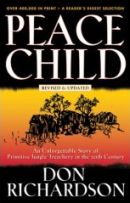 This true missionary story is such an excellent picture of how the Gospel can come in to even the most morally backward culture and transform it from the inside out. It seemed Don and Carol Richardson were up against impossible odds; indeed they were. How can a stone-age tribe who valued treachery more than sacrifice possibly comprehend, let alone believe the sacrificial message of Christ’s redemption for sinners? Only the Holy Spirit alone could make this possible. And at the same time, the Holy Spirit used the difficult work of the missionaries to clearly communicate this message to the Sawi people in Netherlands New Guinea.
This true missionary story is such an excellent picture of how the Gospel can come in to even the most morally backward culture and transform it from the inside out. It seemed Don and Carol Richardson were up against impossible odds; indeed they were. How can a stone-age tribe who valued treachery more than sacrifice possibly comprehend, let alone believe the sacrificial message of Christ’s redemption for sinners? Only the Holy Spirit alone could make this possible. And at the same time, the Holy Spirit used the difficult work of the missionaries to clearly communicate this message to the Sawi people in Netherlands New Guinea.
To start off, Don and Carol had to learn their language. Then they had to attempt to communicate the Gospel, and in so doing, the Sawi people wound up valuing Judas’ betrayal of Christ more than Christ’s sacrifice! How in the world could they possible communicate the Gospel now? Little did Don know God had foreordained redemptive analogies within the Sawi culture long ago that would be used to display the wondrous work of Christ. In order for the tribe to make peace with another tribe nearby where there had been enmity for quite some time, each tribe had to offer a peace child: one of their own children was given over to the other tribe in order to establish peace. And as long as the children lived, there was peace between the tribes, no matter what one did to the other. However, if one of the children died, peace no longer reigned between the tribes.
Don realized he could use this analogy to communicate that Christ is the Perfect Peace Child, the one who was given on behalf of sinners to create peace between us and the true God, forever; and He is the One who will never die, unlike their frail children, in an environment thick with diseases and no cures. Once the Sawi people saw this beautiful display of the Gospel in a way they could finally comprehend and see as valuable, by the work of God’s Spirit alone through the message preached, many believed, and slowly the tribe began changing from the inside out. Over time, through the continued communication of the Gospel, they no longer valued treachery, but rather they valued the Ultimate Peace Child who was given on their behalf so they could be at peace with God. In addition, the Gospel message spread to many of the other tribes and there was unity that had not been there for possibly eons. Not only did the Gospel come in and save their souls from eternal destruction, but it came in and revolutionized the culture, their ethics, value systems, and it reversed the curse of Satanaic darkness that had held this people in spiritual bondage for so long. Praise God for such a wonderful picture of how the Gospel can come in and not only revolutionize individuals but also entire communities!
The Gospel and its message is no different in our Western culture. Though we come from a Judeo-Christian background (or really post-Christian in many respects), we have value systems, beliefs, understandings of reality, that all need healing and reversal by the work of the cross. In the same way the Sawi people were held in bondage by ideas of reality that were lies of Satan (doctrinal error, if you will), so also, our culture has ideas that need reversing by the message of the Gospel. This book is a great illustration of contextualizing the Gospel to a unique people group so they can see the light of Christ. And at the same time, this is exactly what we need to be doing with the Gospel in our own increasingly secularized setting we find ourselves in. With the missionary ideas of Gospel sharing and preaching presented in this book, it is my hope we all realize we too are missionaries in our respective settings and that we have the message of eternal life to present to many who just assume they are Christians because they are Americans.

Leave a Reply